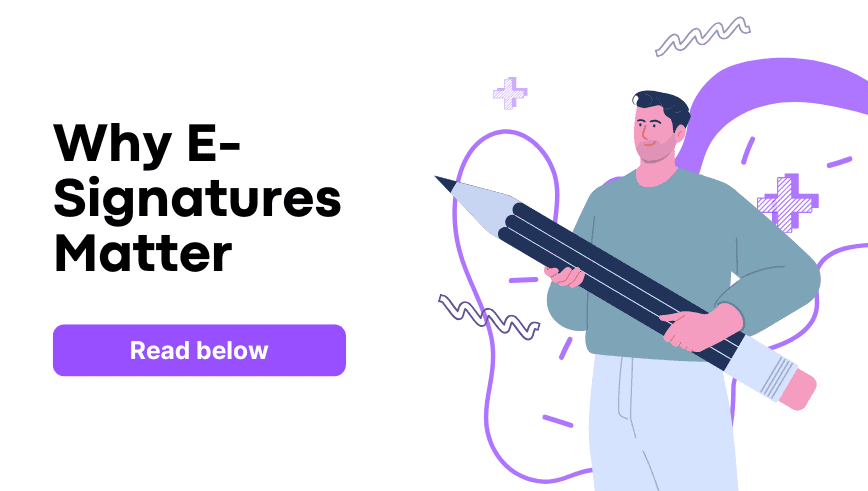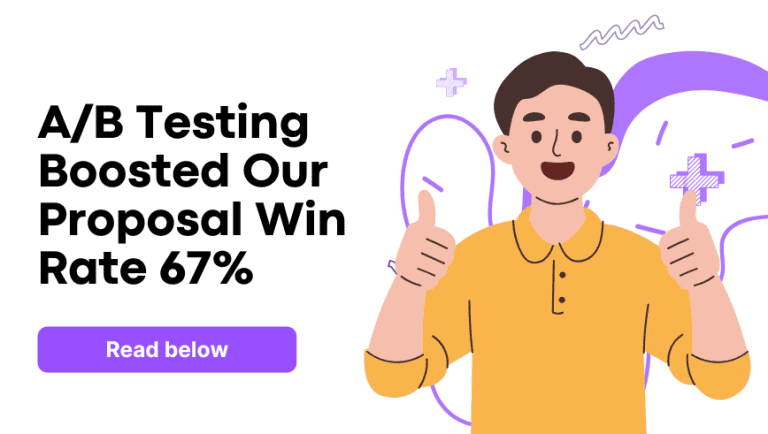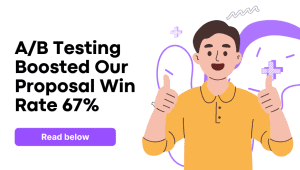You’ve worked hard on a proposal, crafted the scope, calculated the pricing, and built out the delivery plan. And then comes the final hurdle: getting it signed. This is the moment where deals either move forward or fall through. In most cases, what slows down progress isn’t the proposal content but the outdated process that follows. A surprising number of businesses still rely on traditional signing methods. And this can cost more than time. It can cost you the deal.
For teams sending out multiple proposals every week, this bottleneck becomes even more obvious. Clients ask for edits, forget to print the document or push it to next week because they’re traveling. That’s where e-signatures in proposals have become more than a digital upgrade. They’ve become a must-have.
In this blog, we’re walking through everything you need to know about using e-signatures in your proposals. From how they work to why they’re legally accepted, and what features you should look for in a solution, this is the guide we wish we had before switching over.
Why Use E-Signatures in Business Proposals?
For companies navigating the RFP lifecycle, e-signatures also improve internal coordination. If you’re managing complex requests, you might find these insights helpful: best practices for RFP response collaboration.
The act of getting a signature used to involve printers, scanners, and email threads. But the reality of today’s business environment is this: people want to make decisions quickly, and they expect digital experiences that match the speed of their intent.
Using e-signatures in proposals allows clients to sign from any device, at any time. It eliminates back-and-forth follow-ups that usually delay deals. And that’s not all. Clients are often in meetings or traveling, and offering a digital signing experience shows that you respect their time. The moment you remove extra steps like printing and scanning, your chances of a fast close go up.
Over time, we noticed that clients responded to e-signed proposals much faster than traditional PDFs. It wasn’t about the content changing. It was about the convenience and professionalism it conveyed. That’s why more teams now ask: why use e-signatures in business proposals? The answer is simple: because it improves outcomes.
What Is the Importance of Digital Signatures?
Digital signatures carry legal validity. They are recognized across countries through regulations such as the ESIGN Act in the United States and the eIDAS Regulation in Europe. These legal frameworks allow businesses to collect and rely on e-signatures in proposals with confidence.
But the real importance goes beyond legality. Digital signatures include technical metadata, such as timestamps, device identifiers, and audit trails. This data supports authenticity and can be helpful in case of disputes. So the value is twofold. You get an efficient signing process, and you also get a traceable, secure record.
When we first started using digital signatures, we didn’t fully understand how secure and formal they really were. It was only after reading up on the laws and speaking to legal professionals that we realized this wasn’t just a modern convenience. It was a reliable alternative to pen and paper that held up just as well in court.
So if you’re asking, what is the importance of digital signatures? The answer is both legal and operational. It supports your workflow while providing you with documentation you can trust.
The Benefits of Electronic Signatures in Proposals
Before we look at this in-depth, it’s worth considering how e-signatures play a role throughout the broader RFP process.
The benefits of electronic signatures are easy to spot once you start using them, but here are some that stand out in real-world proposal processes:
- Faster deal closure: Clients can sign instantly, even from a phone, while they’re reviewing the proposal.
- Fewer drop-offs: Every time a client delays signing due to logistical issues, there’s a risk of losing the deal. E-signatures make signing immediate and easy.
- Clearer tracking: You get notifications when the proposal is viewed, signed, or even declined. This helps you stay ahead in communication.
- Better documentation: Unlike physical signatures, each e-signature in a proposal leaves behind a full audit trail. This includes information like time, IP address, and signer identity verification.
And the best part? You don’t need to be a tech-savvy business to use these benefits. Even small teams, freelancers, and consultants have started including e-sign options in their proposals because they work.
Myths and Facts About E-Signatures
Many businesses are still unsure about switching to digital signatures. So let’s take a look at some common misunderstandings and the facts that clear them up.
Myth: E-signatures are not legally valid.
Fact: They are. E-signatures are accepted under laws in most parts of the world, including the ESIGN Act in the US and eIDAS in Europe.
Myth: Digital signatures are risky or unsafe.
Fact: In reality, many digital signature tools offer encryption, verification, and tamper-evident records. They often provide more traceability than a handwritten signature.
Myth: Only large corporations benefit from them.
Fact: Startups, independent professionals, and even NGOs use e-signatures in proposals to streamline their work.
Myth: It’s complicated to implement.
Fact: With the right electronic signature software, it’s a simple drag-and-drop process. Most tools walk you through adding signature fields in minutes.
Being aware of these facts helps in making informed decisions. Once you realize the legal and technical soundness of e-signatures, their value becomes obvious.
How to Collect E-Signatures on Your Proposals
If you’re wondering how to collect e-signatures on your proposals, it usually involves just three simple steps:
- Choose a proposal platform that supports e-signatures.
- Add signature fields to your proposal. Make sure to include both client and internal signers if required.
- Send the proposal and let the platform handle notifications and tracking.
You don’t need separate PDF tools or long how-to guides. Just choose a tool that integrates signing into your workflow and keeps everything in one place.
This experience becomes even smoother when the signature tool is part of your proposal software. You’ll spend less time jumping between platforms and more time focusing on the content of your offer.
When Do You Need E-Signatures in Proposals?
Businesses often ask: When is it essential to use an e-signature rather than just an approval email?
The short answer is when there’s any legal or financial stake involved. This includes project quotes, contracts, service agreements, onboarding documentation, and multi-party approvals. Using E-Signatures in Proposals ensures a formal acceptance process with traceability, and in many industries, that level of formality is expected.
If you’re working with external vendors, public-sector clients, or regulated sectors like healthcare or finance, digital signature workflows reduce risk and simplify compliance. They also provide proof of consent, which can be critical if terms or deadlines are disputed later.
This is where the benefits of electronic signatures go beyond speed—they support business clarity and trust.
Real-World Use Cases Across Industries
While the use of e-signatures in proposals is common across sectors, understanding the difference between proposal types also impacts how you apply e-signatures. A few examples:
- A marketing agency sends creative pitches with pricing and deliverables. Their clients sign directly from their mobile.
- A SaaS company shares technical implementation documents with IT managers and legal teams. The signature trail is part of their internal compliance.
- A consulting firm uses it to approve multi-stakeholder projects with signatures from different departments.
- Freelancers use it to secure project approvals without needing any in-person meetings.
These are not niche examples. These are everyday business workflows, made more efficient by e-signatures.
What to Look for in a Good E-Signature Tool
There are a myriad of proposal-building and RFP writing tools on the market, and many of them include the e-signature feature. However, the fact of the matter is that not every tool is built the same. If you’re evaluating electronic signature software, here are a few practical things to consider:
- Can it be embedded inside your proposal, or is it a separate step?
- Does it track when the document is opened or signed?
- Does it support team-based workflows?
- Is the client experience simple enough that it requires no explanation?
- Can you brand the signature flow with your logo, colors, and domain?
A good tool doesn’t overwhelm the client or your team. It sits quietly within your proposal flow and gets the job done.
Why Timing Matters in Proposal Acceptance
We all know what happens when a proposal sits too long in an inbox. Momentum slows, priorities shift, and the opportunity fades. By using e-signatures in proposals, you can reduce that delay. Clients are much more likely to act while the pitch is fresh in their minds.
Many businesses underestimate how important that final moment of action is. Everything else might have gone right: presentation, demo, pricing, but the actual signing part needs to feel just as frictionless. That’s where e-signatures really shine.
You’re not just making your life easier. You’re giving your client a better experience that reflects your company’s responsiveness and attention to detail.
Features to Prioritize If You Need E-Signatures in Business Proposals
If your business is evaluating tools, the real question isn’t just “Does it support signing?” It’s why use e-signatures in business proposals and which features actually help.
It will help to keep a lookout for these:
- Built-in e-signatures inside your proposal builder, so there’s no need to send clients to another app.
- Client-friendly signing experience, especially for mobile users.
- Branded proposals, so your logo and colors show up even during the signing step.
- Signing status and activity logs, so your team can follow up with real data.
- Support for multi-party signing, if you often deal with layered approvals.
All of this helps you manage e-signatures in proposals efficiently, with fewer delays and clearer records. It’s not just about digitizing the last step—it’s about removing hesitation from the entire closing experience.
What Happens When You Start Using E-Signatures in Proposals
If you’re looking to streamline how fast you get responses, e-signatures are just part of the solution. You might also want to read our guide on how to respond to an RFP faster.
Using e-signatures in proposals is not about being trendy. It’s about improving communication, speeding up sales, and showing that your business understands how modern deals are done. Every time a proposal gets signed faster, you’ve not only saved time you’ve also increased the chance of a win.
At Proposal.biz, we’re building a tool that brings proposals and e-signatures together in one space. It’s still in development, but our goal is clear. We want it to be intuitive, flexible, and accessible to businesses of every size. Whether you’re closing your first client or sending your 500th proposal, the experience should feel seamless.
If this blog helped clarify the role of e-signatures in your proposal process, stay connected. We’re building something to make that next step even easier.
Stay tuned. Your next proposal might just be your best one yet.




